Upgraded thermal imaging technology is being offered to the British Army as part of Team Challenger 2’s bid to upgrade the Army’s Main Battle Tank.
The Challenger 2 Life Extension Project (LEP) is a UK MOD contract to remove obsolescence from Challenger 2 and extend its out-of-service date by ten years to 2035, and is worth over £700m.
The technology, developed by Leonardo in the UK, forms part of the BAE Systems led bid to upgrade the tank and would for the first time bring independent night vision for both the gunner and the commander.
Also known as ‘electro-optic technology’, the thermal imaging system will help British troops identify potential threats and move undetected in hostile situations, while also shaving valuable seconds off reaction times, which can make the difference between mission success and failure.
The company say that instead of sensing light like a standard digital camera, Leonardo’s infrared camera senses heat emitted by all objects with temperatures greater than absolute zero (-273°C).
The hundreds-of-thousands of individual pixels in the camera, each one-twelfth the thickness of a human hair, can detect temperature differences as small as one-fiftieth of a centigrade, allowing for extremely sharp images.
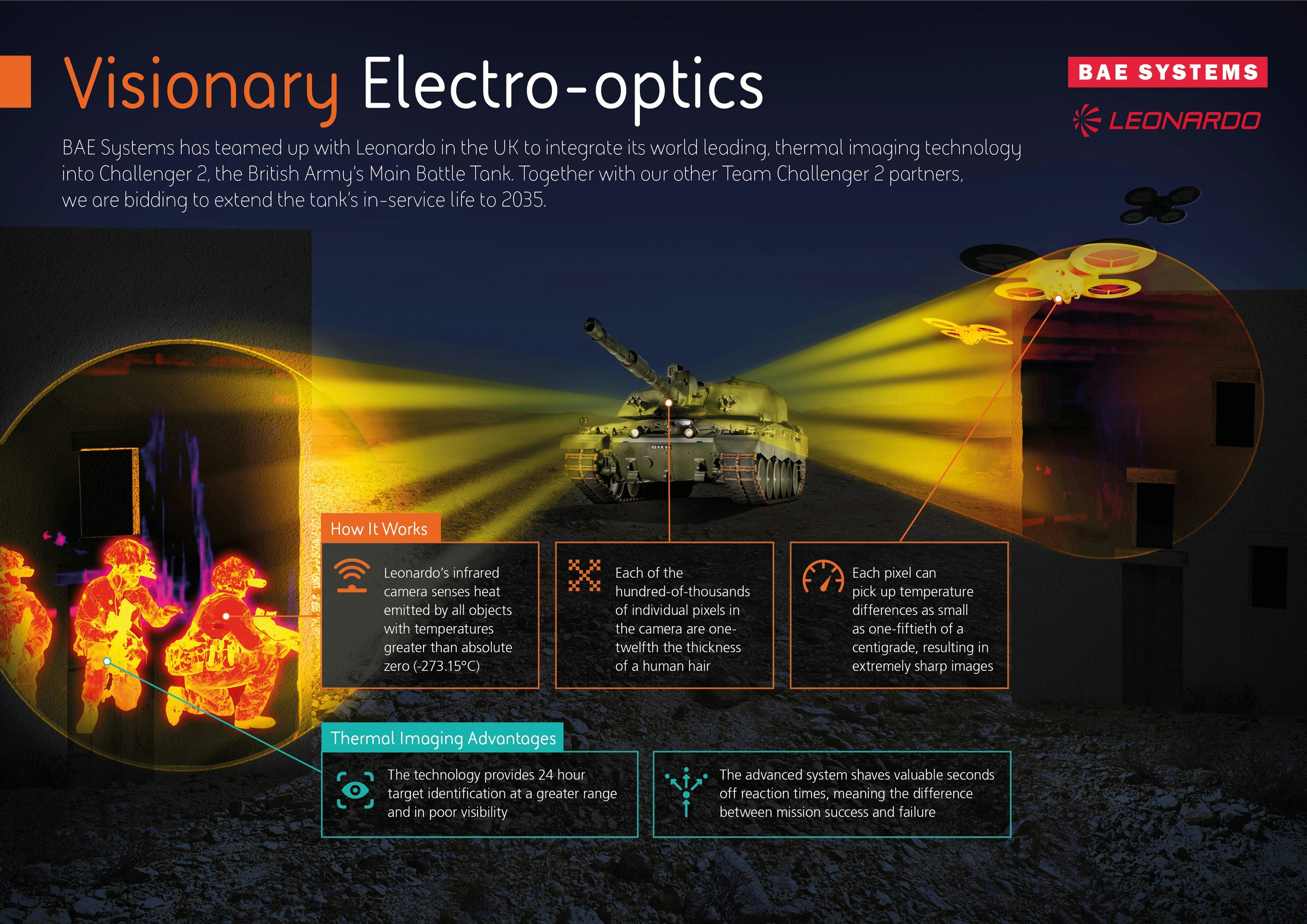
Simon Jackson, Campaign leader for Team Challenger 2 at BAE Systems said:
“Leonardo’s sight brings to Team Challenger 2 the most capable night vision available. Combined with our engineering skills and knowledge of Challenger 2 – which we designed and built – we will work together to integrate Leonardo’s technology seamlessly into the tank, sharing data across crew stations and with battle management computers.
Sighting is a vital element of a battle tank’s role and Leonardo’s sight will provide our troops with unparalleled 24-hour night-and-day visibility, giving them a long-range threat identification system that really makes the most of the tank’s firepower.”
Mike Gilbert, SVP Optronics Systems UK at Leonardo, said:
“Our thermal cameras – designed and built in the UK – can ‘see’ in total darkness as far as the horizon, and the applications for this technology are endless – from helping improve our understanding of the natural world to improving the operational capabilities of the British Army’s Challenger 2 Main Battle Tank.
Our infra-red technology plays a crucial role in supporting British troops in the most challenging environments and we’re pleased to be working alongside BAE Systems to offer this technology for Challenger 2, helping extend its life to 2035 and beyond.”
The firm say that the technology is already proven on other military platforms – such as the Royal Navy’s Queen Elizabeth Aircraft Carrier and the Royal Air Force’s Chinook fleet – but has wider applications, including being used by leading broadcasters to capture some of the most difficult shots possible for television.
In David Attenborough’s Planet Earth II documentary, cameras equipped with Leonardo’s technology allowed the filmmakers to capture the most detailed film ever seen of a leopard’s nocturnal hunt, down to the movement of individual hairs on its body. While in the fast-paced world of sport, the Hot Spot system used in international cricket incorporates Leonardo’s thermal imaging technology, helping umpires see whether a ball has struck the batsman, pad or ball, by looking for a temperature change caused by the friction of impact.
From a military standpoint, the thermal imaging system was previously used in Afghanistan to allow Chinook Helicopters to fly undetected through mountain valleys, even in poor weather conditions. It also brought the ability to detect, recognise and identify coalition troops or vehicles at a safe standoff range prior to entry into drop or landing zones.
Rheinmetall has also submitted a comprehensive offer to extend the life and substantially upgrade the capabilities of the Challenger 2 tank fleet in response to the Challenger 2 Life Extension Project. More information on the competition can be found here.



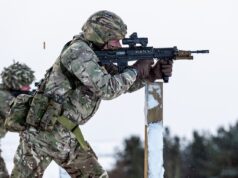
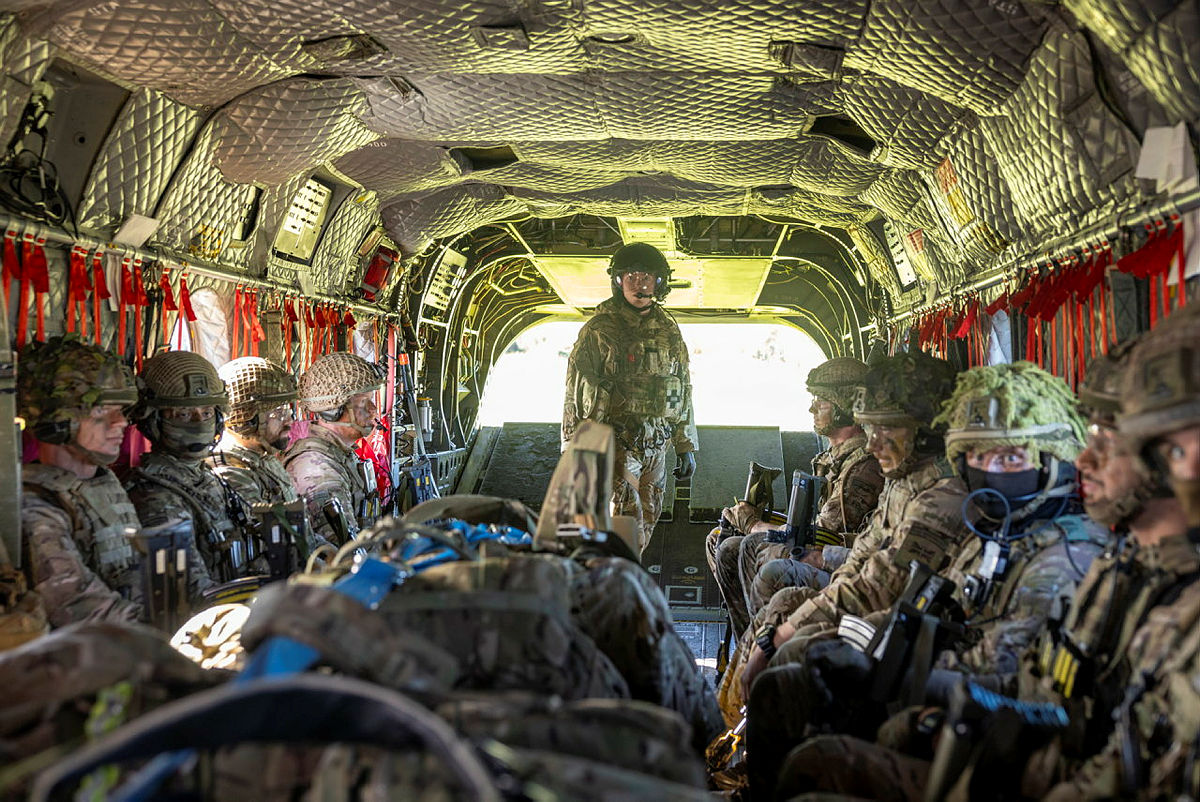
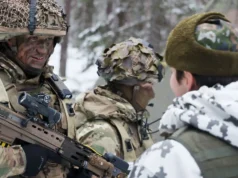
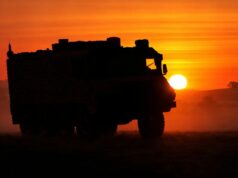

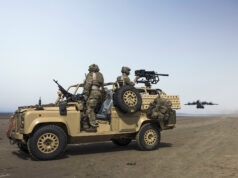

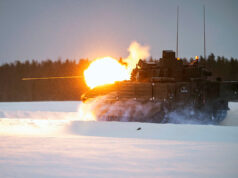



Have some of the dates changed on this project? I understood initially, an announcement would be made on the winning team in August 2018? However, I’ve also read it will now be 2019 if so, the programme is already falling behind.
Is HMG delaying until after Brexit before making a decision? We could end up with more money in the pot if it’s a no deal!
I believe over three hundred CH2’s were built, so why can’t at least another 50 hulls be included to provide the latest upgrade for a true reserve fleet? As for Brexit, it will be all down to the wire, and many manufacturers in Europe and the UK will be hoping common sense will prevail, including the defence industry.
1. the tooling doesn’t exist any more
2. there aren’t 300 challys driving about. the fit for deployment % would make you wince.
3. common sense and MOD arent mutually exclusive. You should know that by now.
Don’t understand what you are saying? What has tooling to do with it? Those remaining hulls and turrets (beyond the serviceable 227) should still be extant as I’ve not seen any evidence of CH2 on the scrap heap? If you know of such evidence I would be interested to see it.
Maurice – a total of 386 C2’s were built for the British Army plus a small number of training tanks,38 more were exported to Oman.Post 2003 Iraq about a third of the BA fleet were subjected to the equivalent of the Tornado RTP process so there are no real spares as such,plus as has been noted here the means to manufacture any more has long since gone
BAE Systems Technology Demonstrator has been revealed,its called Black Knight,looks to be quite an interesting proposition.
I wonder how much detail is classified for these programs. There hasn’t been much info other than to say they are updating optics, fire control systems wiring etc.
For example could a C2 operate a mini UAV or link to watch keeper following this upgrade; to scout, calculate distance and engage a target without exposing itself to line of site?
After the pumiling the Lepoard II’s took in Turkey suddenly the Challenger 2 looks like a better tank that many had thought. Even the Abrams has not stood up to the same level of punishment a Challenger 2 has.
Its unfortunate that the riffled 120 mm gun cant be replaced by the smooth bore although its worth noting that this gun still holds the absolute record for a tank kill n terms of distance. Sure it might struggle at range against the handful of T14’s the Russian’s are able to produce but the vehicle is much more likely to encounter large number’s of T72 derivatives or anti tank weapons and it is probably superior to M1 or Leopard in dealing with such threats.
Hopefully with replacing sensors, power pack etc the vehicle can be kept relevant until we are ready to move up to 130 mm weapon.
The CH2 proved to be possibly the best MBT when in action in Iraq. Any subsequent opinion has only strengthened that conclusion. That is why I’ve been puzzled by the recent nonsense of it being the wrong tank for Britain?
Don’t take anything away from the CH2, but the Leopards used in Turkey were several iterations older than CH2- a better comparison would be CH1 I believe. They were also used awfully by the Turks; positioned without infantry support on ridge crests etc. where they were easy targets for ATGMs. In that situation, where fairly modern guided missiles were able to be launched at lesser protected areas, I’m not sure even a CH2 would have come off completely unscathed- although I doubt it would have been a full kill.
The CH2 has great armour, but mobility can only be described as poor and the comms, optics and control systems haven’t been upgraded in too long. With a decent upgrade package, it would be top notch again, but at the moment it’s a tad long in the tooth. The newest Merkava’s have Trophy, full data uplinks and are just being fitted with a VR view system that gives full 360 degree vision “through” the tank. M1A2s have new data systems, uprated optics, remote turrets for the external machine gun, uprated transmissions and armour and seem to be about to be fitted with Trophy (they have also already announced their next round of upgrades). That’s how you keep an old design at the forefront of combat systems.
I wonder if electric propulsion is a way of increasing the road/terrain issues you raised? As the battery technology increases it may be possible to package enough power and hours, to make it a viable alternative to liquid fuels? Charging in the field would possibly require more support systems than currently deployed in the fuel logistic fleets? However, the CH2’s basic body structure has plenty of life left in it, but lighter /tougher track and wheels, made from advanced materials could reduce some weight without hampering the tanks overall firepower and operability?
It’s an interesting question, there are a lot of advantages to electric drive like max torque all the time, and braking.
I guess the challenge will be energy storage as you say, as they’ll also have to feed all of the electrical systems on board (increasing in requirements all the time, and likely more so with directed energy weaponry).
A bridging solution might be diesel electric, like trains and ships. All the benefits of the electric motors while the efficiency and fuel economy of a relatively low-revving diesel. Mind you, that kind of power system has been around for ages now, so there must be a reason why no-one has done it…
So the British army’s MBT is going to get at some point in the 2020’s tech that the BBC and sports organisations have had for some years!!! It used to be military tech was found its way into the civilian world after several years of classified use now it seems the reverse and usually at several times the cost.
The issue is no one fought a tank war for 15 years and Budget went else where, defence electronics have always lagged commercial market.
Sure look at body armour, night vision, an endless list of rifle attachements and optics that have been developed commercially that is superior to military equipement and ends up purchased as an UOR. Military procurement is so beurocratic by the time is deployed it’s yesterday’s technology. If the electronics on he C2 have not been upgraded since 1998 think of how far they will be behind the latest night vision and thermal optics that are available today.
We also don’t have the budget to update equipement everyone some new comes along which is why things get upgraded so quickly when we got to war and all of a sudden the treasury is funding UORs left right and centre. It’s just a disgrace we have to sell it off as soon as the deployment ends. It’s a disgraceful waste our taxes. That leaves our military illequiped again.
The MoD could learn a lot from the commercial sector in areas like agile project management
It’s nothing against Challenger 2 in particular but MBT’s in general. £700m is very expensive lipstick on a pig. How many more Apaches could we buy with that ?
700m/35m = 20 Apache.
But the running costs are 45,000 quid an hour, so about 70x a CR2.
And just try using your shiny helicopter when there is any sort of AA threat. Its what the kids call a “Glass Cannon”.
MBT’s will always be needed. Coupled with an appropriately sized Apache fleet gives a potent offensive force. But in reducing that force by a third as we have done criminally weakens our potency on the battlefield as a credible fighting force in anything but relativel small scale actions.
The CH2 meanwhile is too bloody slow and needs a 25% power upgrade. Still a very hard nut to crack.